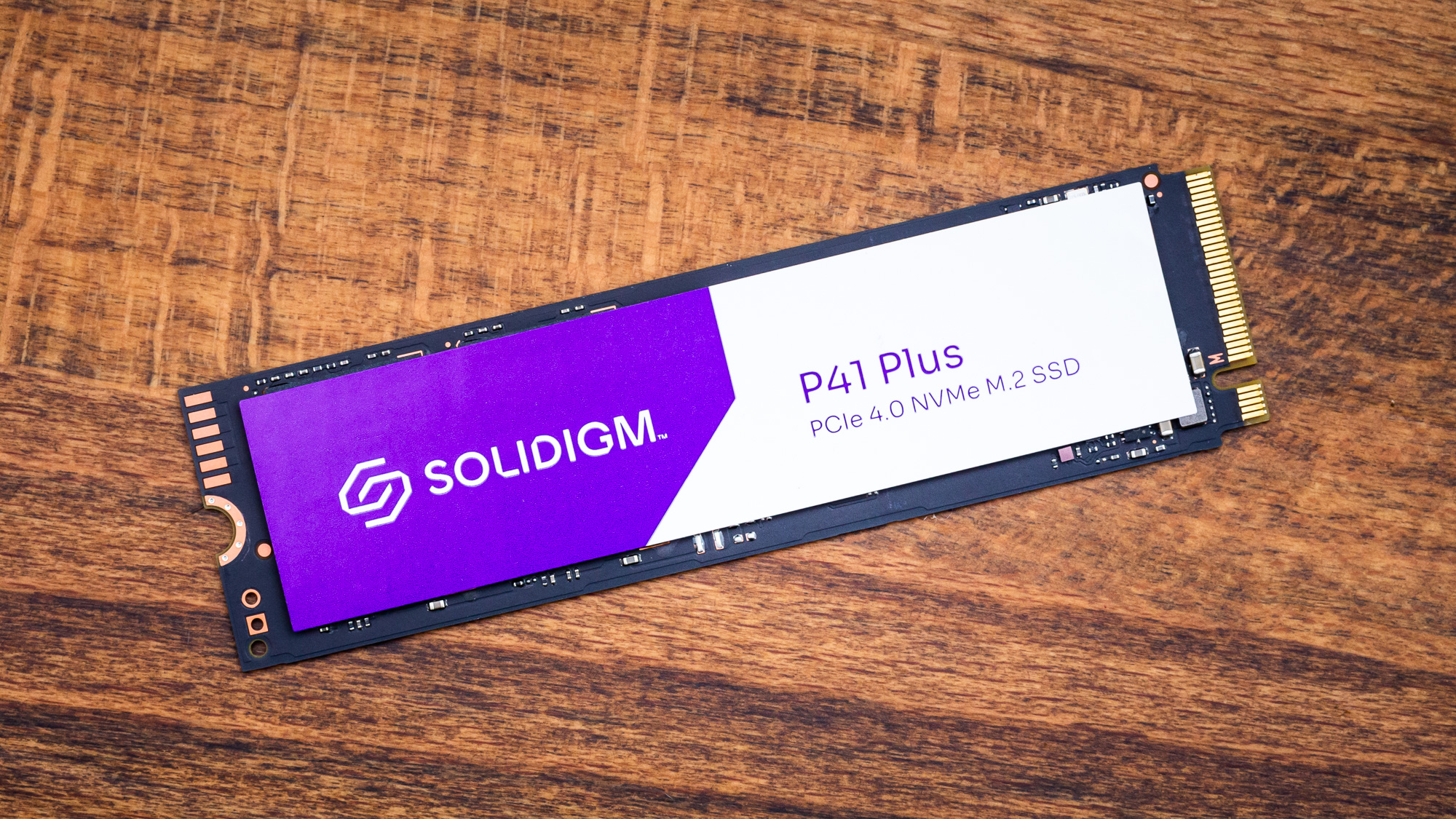Why you can trust Tom's Hardware
Solidigm P41 Plus SSD (1TB)
RATING: ★★★ (3 Stars)
PROS
+ Nice first product from Solidigm
+ Good support with a reasonable warranty
+ Hybrid pSLC cache with read capability
CONS
- DRAM-less with largely mediocre performance
- Entering a crowded market
OUR VERDICT
The 2TB Solidigm P41 Plus is a competent first effort that yields a capable mid-range PCIe 4.0 SSD built on QLC. The hybrid cache and strong support make it attractive, especially as it runs cool, but the market is crowded and its performance is largely average. If priced right, it’s a good budget primary SSD.
Comparison Products (1TB)
As the Solidigm P41 Plus is essentially the successor to the Intel 670p, we compare it to that drive. QLC alternatives include the Crucial P3 Plus, the Sabrent Rocket Q, and the Sabrent Rocket Q4. WD’s SN770 is a direct competitor with TLC. We also compare our best drive from Solidigm’s parent SK hynix, the Platinum P41. Lastly, we have the Crucial P5 Plus.
Get Tom's Hardware's best news and in-depth reviews, straight to your inbox.
Trace Testing - 3DMark Storage Benchmark
Built for gamers, 3DMark’s Storage Benchmark focuses on real-world gaming performance. Each round in this benchmark stresses storage based on gaming activities including loading games, saving progress, installing game files, and recording gameplay video streams.
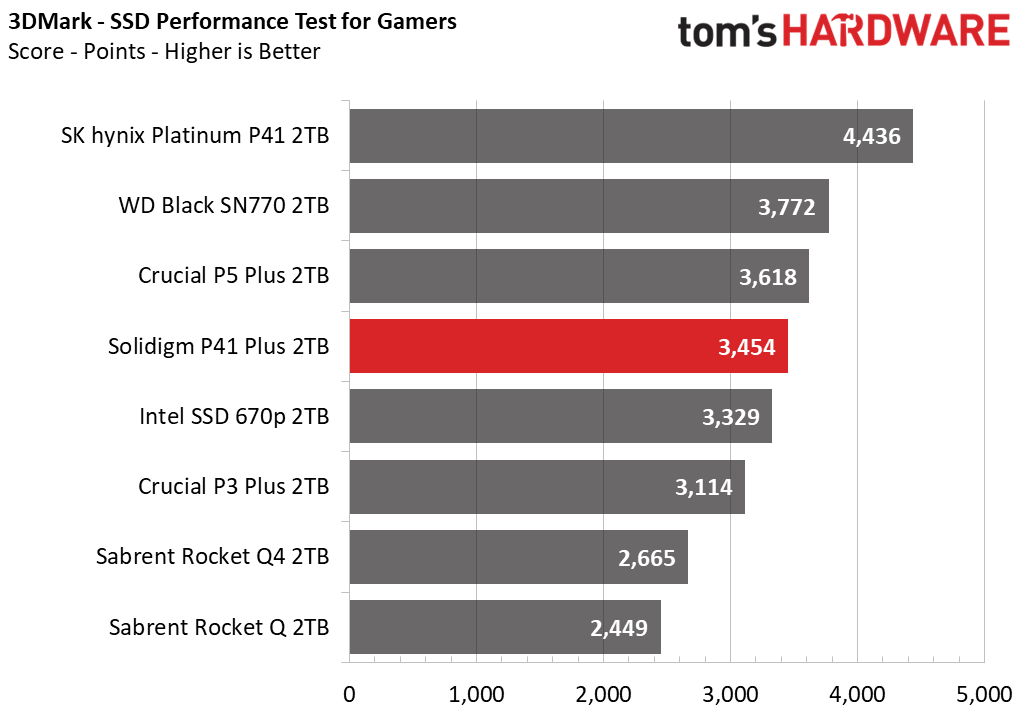

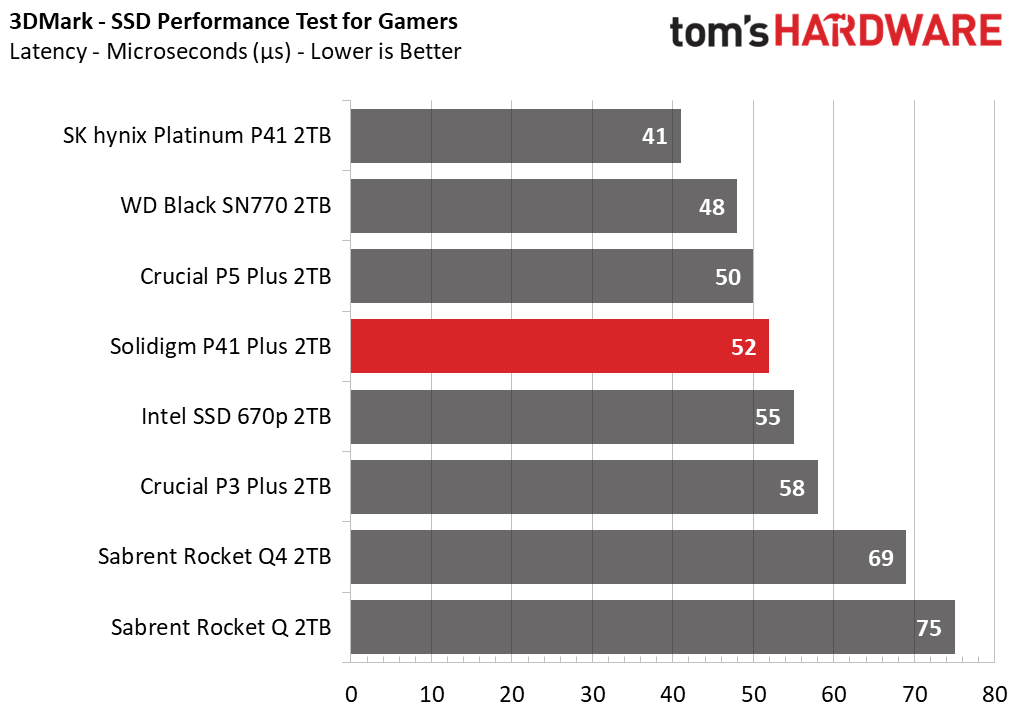
The P41 Plus ends up in the middle of the pack, which is actually a good showing. It beats all of the other QLC drives, demonstrating the ability of new hardware to improve performance significantly. The exception would perhaps be the P3 Plus, which uses a new controller and new QLC, although it does well enough and is, in any case, intended to be a budget drive up to 4TB.
Trace Testing – PCMark 10 Storage Benchmark
PCMark 10 is a trace-based benchmark that uses a wide-ranging set of real-world traces from popular applications and everyday tasks to measure the performance of storage devices.

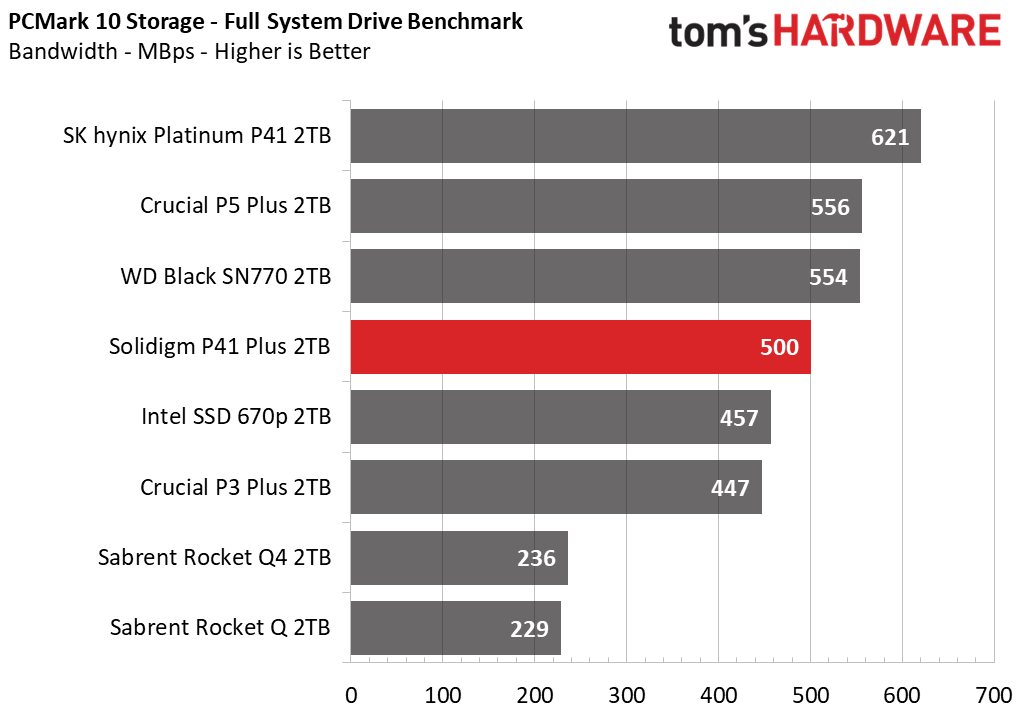
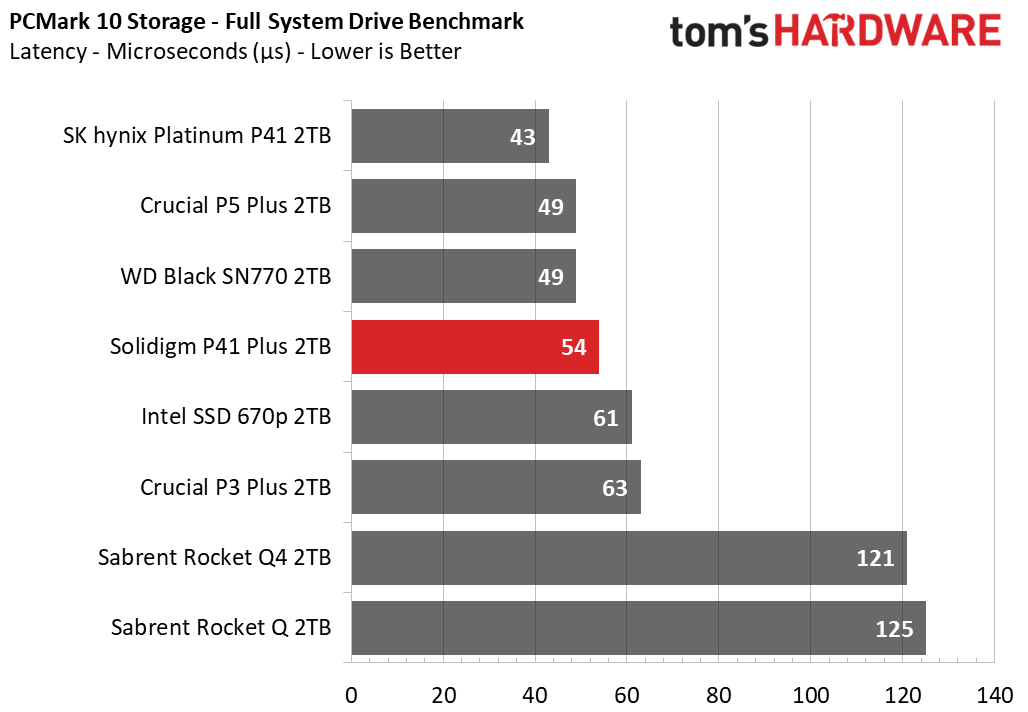
As expected, the P41 Plus again performs near the middle of the pack, doing well enough even to encroach a bit on the TLC SN770. The SN770 is a strong example of a mid-grade PCIe 4.0 TLC drive. So many strong options can make it difficult to pick the right drive, but QLC tends to be the better option for capacity, while many budget TLC drives are aimed at 1TB.
Transfer Rates – DiskBench
We use the DiskBench storage benchmarking tool to test file transfer performance with a custom, 50GB dataset. We copy 31,227 files of various types, such as pictures, PDFs, and videos to a new folder and then follow-up with a reading test of a newly-written 6.5GB zip file.

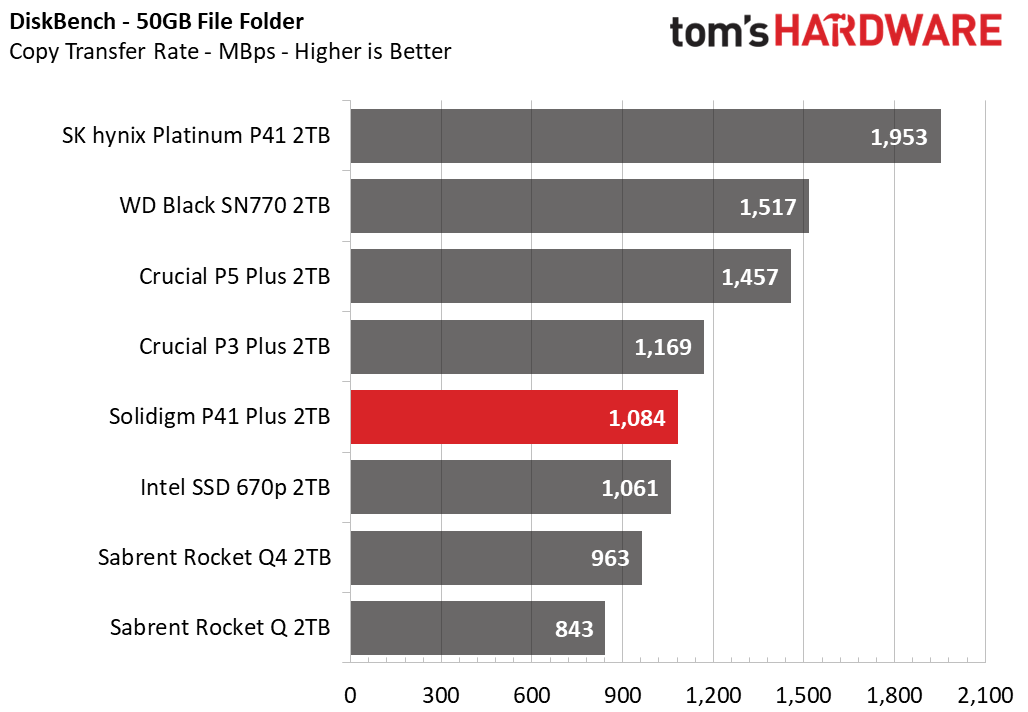
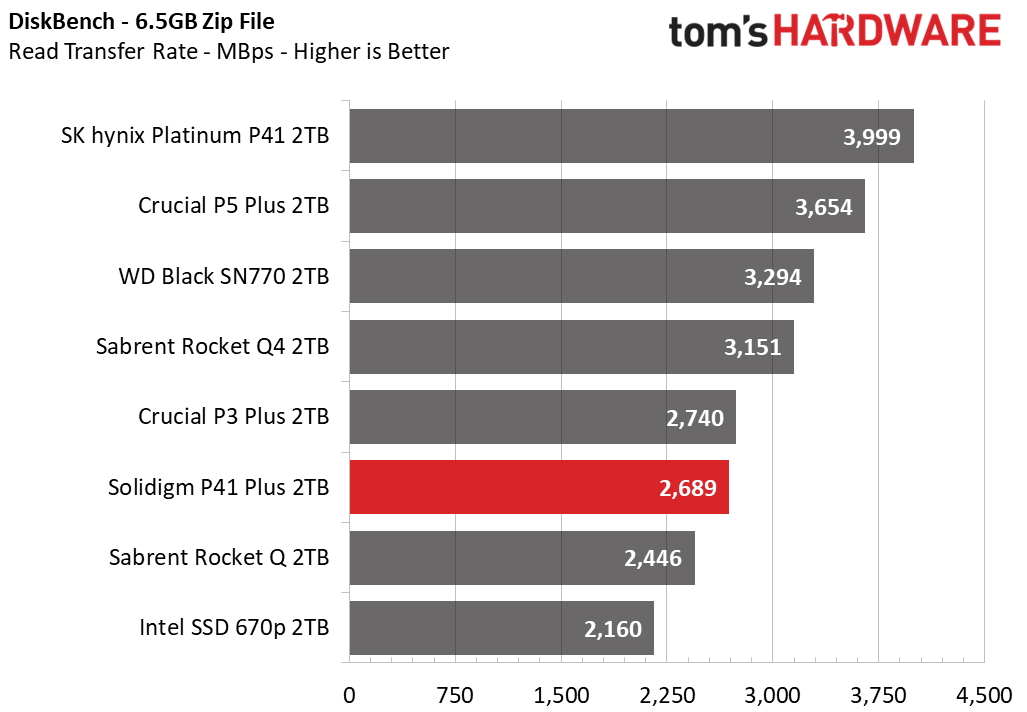
The QLC drives generally underperform during the read workloads in this test, a consequence of slower native read latency and potentially fewer planes due to density. Most flash is trending towards a four-plane design, and TLC usually requires more dies to reach any given capacity. In addition, QLC requires higher read precision due to having more bits per cell, which inevitably slows the average response time. There have been innovations in this area, such as with independent plane reads and more intelligent write behavior — for example, writing hotter data in lower pages that are read more quickly.
This is different for writes as these tend to fall in single-bit pSLC that is generally of a similar speed for consumer flash, whether it be TLC or QLC. With sufficient dies, you are limited by the interface and/or the controller by its bus speed. Copy performance can reveal a little bit more as it will be bottlenecked a bit by QLC read performance. As such, the P41 Plus is pretty close to the 670p, which uses the same flash. Older QLC falls more behind and TLC, in general, does well. Perhaps the most interesting result is from the P3 Plus, as it uses Micron’s rival QLC, but performance is pretty close.
Synthetic Testing - CrystalDiskMark
CrystalDiskMark (CDM) is a free and easy-to-use storage benchmarking tool that SSD vendors commonly use to assign performance specifications to their products. This tool gives us insight into how each device handles different file sizes.
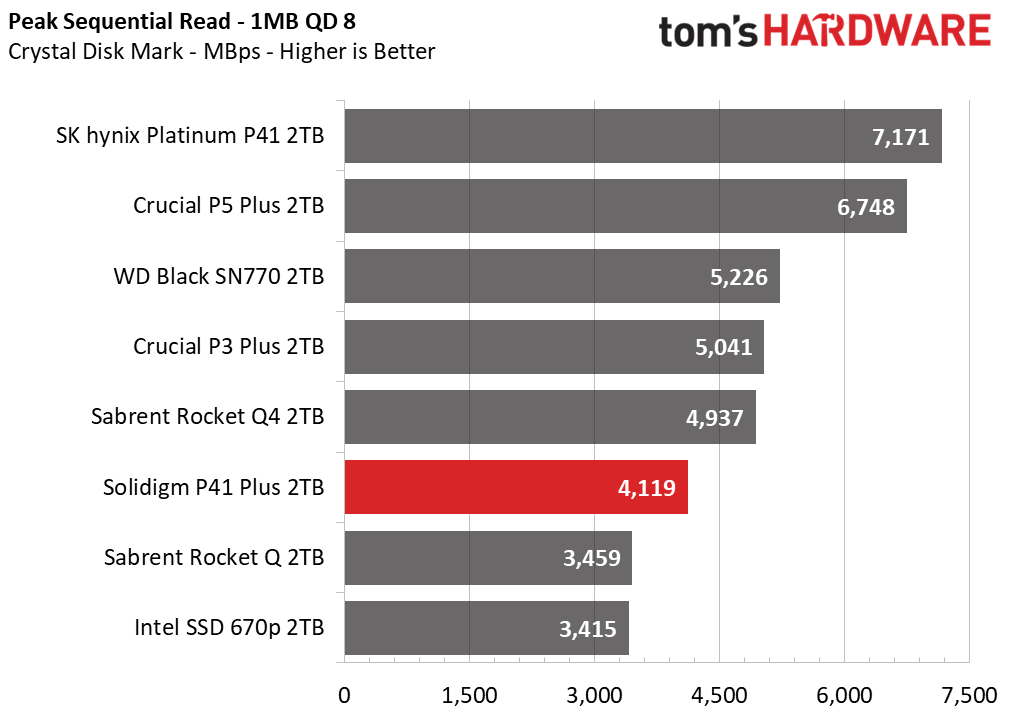

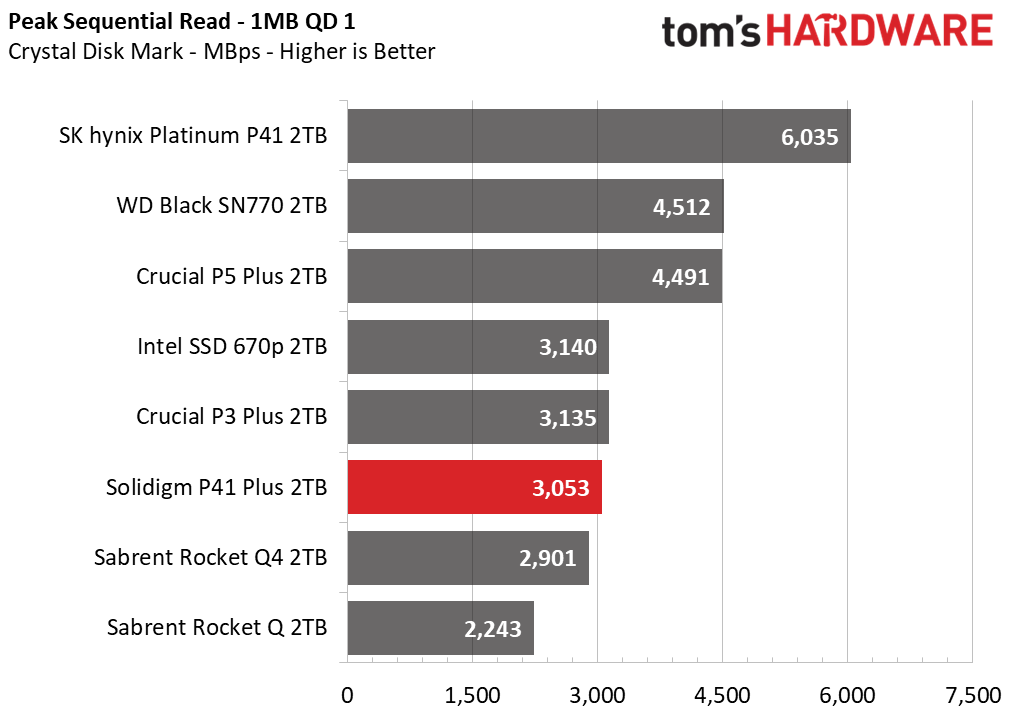
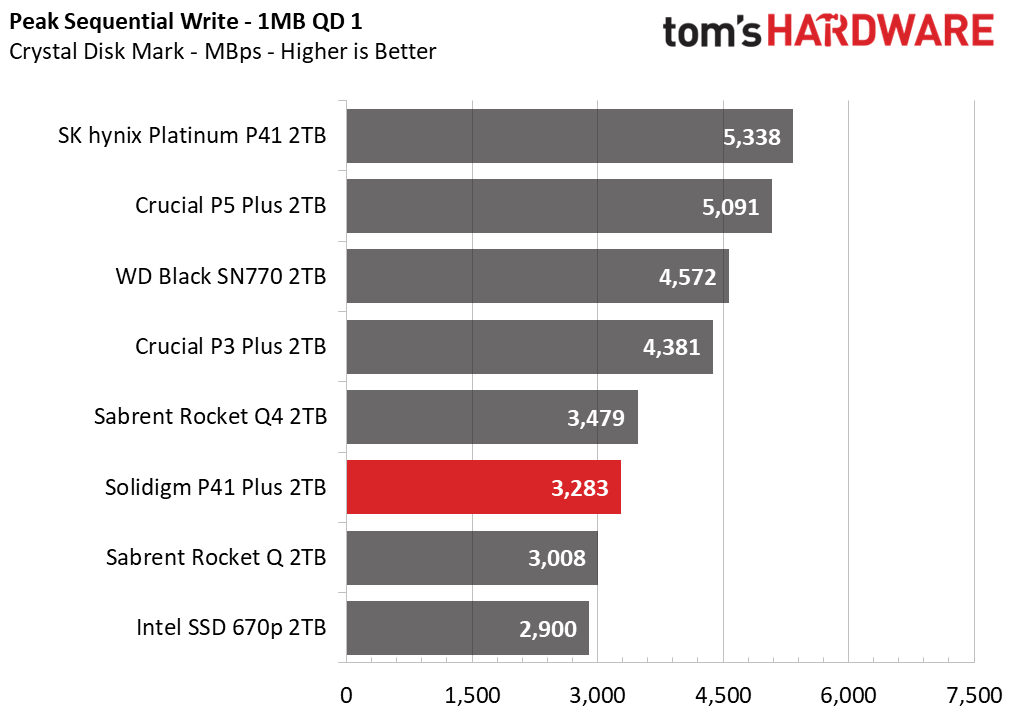



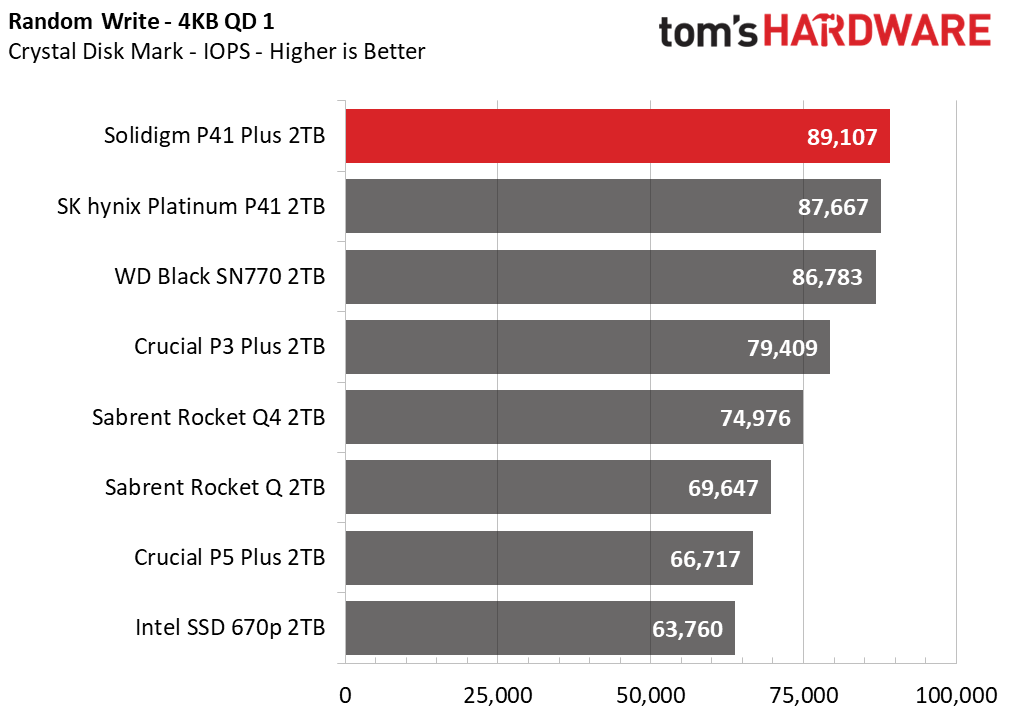
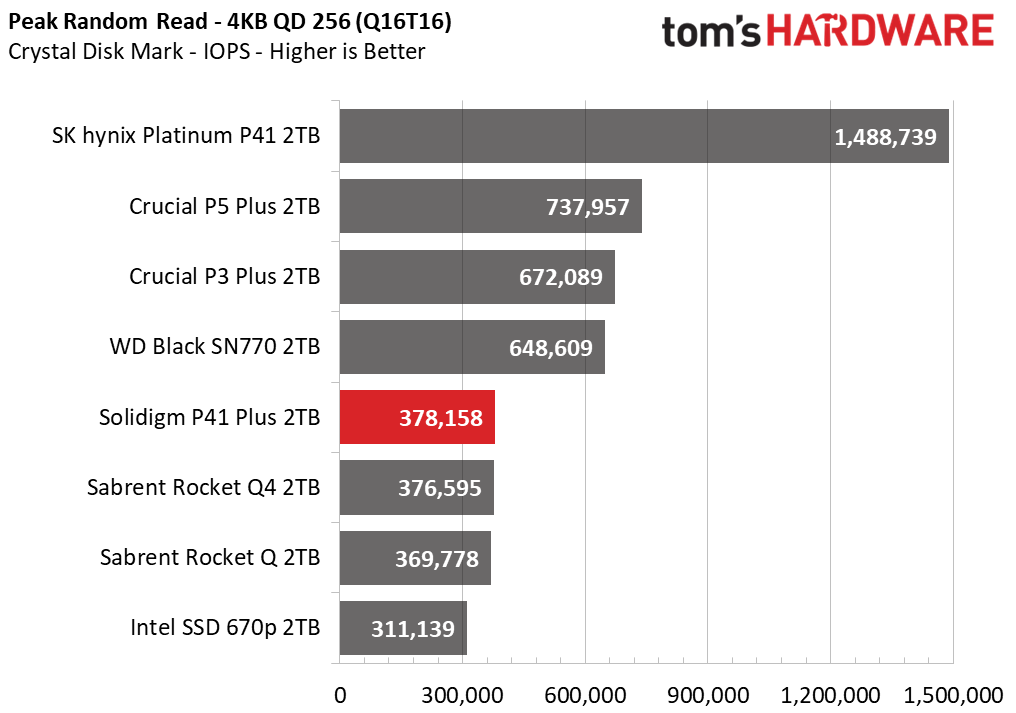
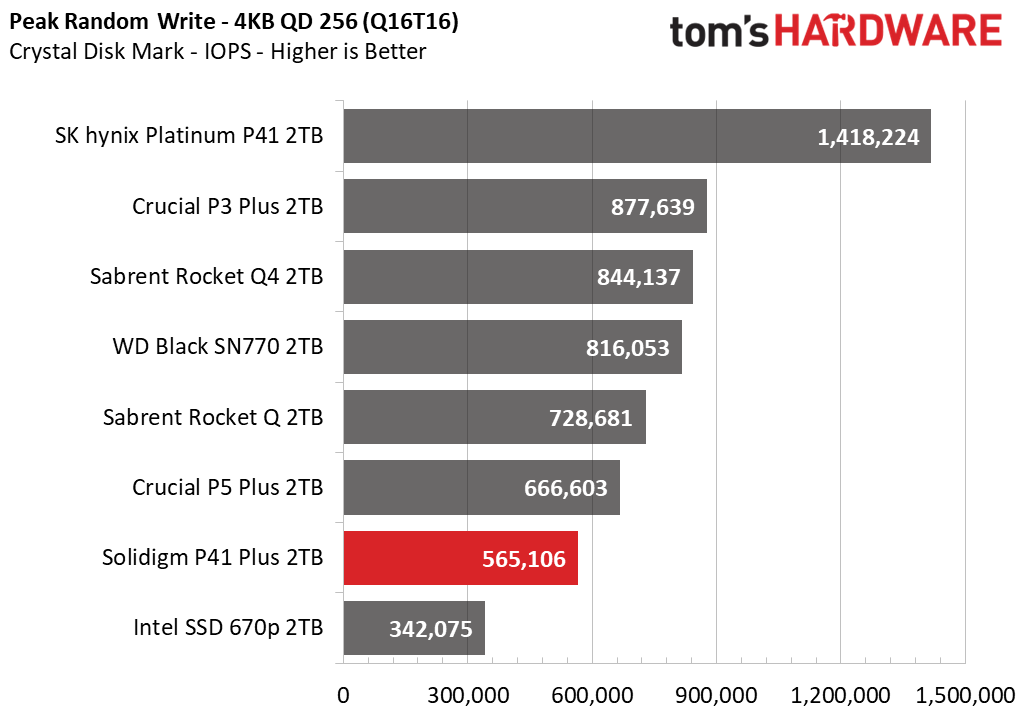
Sequential performance is bound by the interface, such that the PCIe 4.0 QLC drives — the P41 Plus, P3 Plus, and Rocket Q4 — clearly beat the 670p and Rocket Q. However, the P41 Plus is at the bottom versus the other two. One reason is that Phison controllers are known for peak sequential performance. This puts the P3 Plus atop these three drives as it also has newer flash than the Rocket Q4. The TLC drives, particularly the Platinum P41 and P5 Plus, easily outperform the QLC options.
Performance in random workloads tends to be more important, and the P41 Plus shines here. It is important to remember that the P41 Plus is a successor to the 670p. The 670p also uses an SMI controller, albeit with different cores and DRAM. Historically, SMI controllers have done well with random read performance, so it isn’t surprising to see these two drives near the top during testing with low Queue Depths (QD). More surprising is the random write performance, which has the P41 Plus on top during the low QD test. High QD is, as of yet, less critical but varies with the controller's horsepower.
Several factors influence total latency. Most of the delay is when reading or writing from flash, as it is the slowest link in the chain. The impact of DMA buffers and bus transfer times are relatively small, as can be ECC. In this case, with low QD writes, the strong performance of the P41 Plus may stem from the new controller. The Cortex-R8 allows for wide power calibration for potentially very fast access times, although, as suggested above, on paper, it is less efficient under load than the R5.
Sustained Write Performance and Cache Recovery
Official write specifications are only part of the performance picture. Most SSDs implement a write cache, which is a fast area of (usually) pseudo-SLC programmed flash that absorbs incoming data. Sustained write speeds can suffer tremendously once the workload spills outside of the cache and into the "native" TLC or QLC flash. We use Iometer to hammer the SSD with sequential writes for 15 minutes to measure both the size of the write cache and performance after the cache is saturated. We also monitor cache recovery via multiple idle rounds.
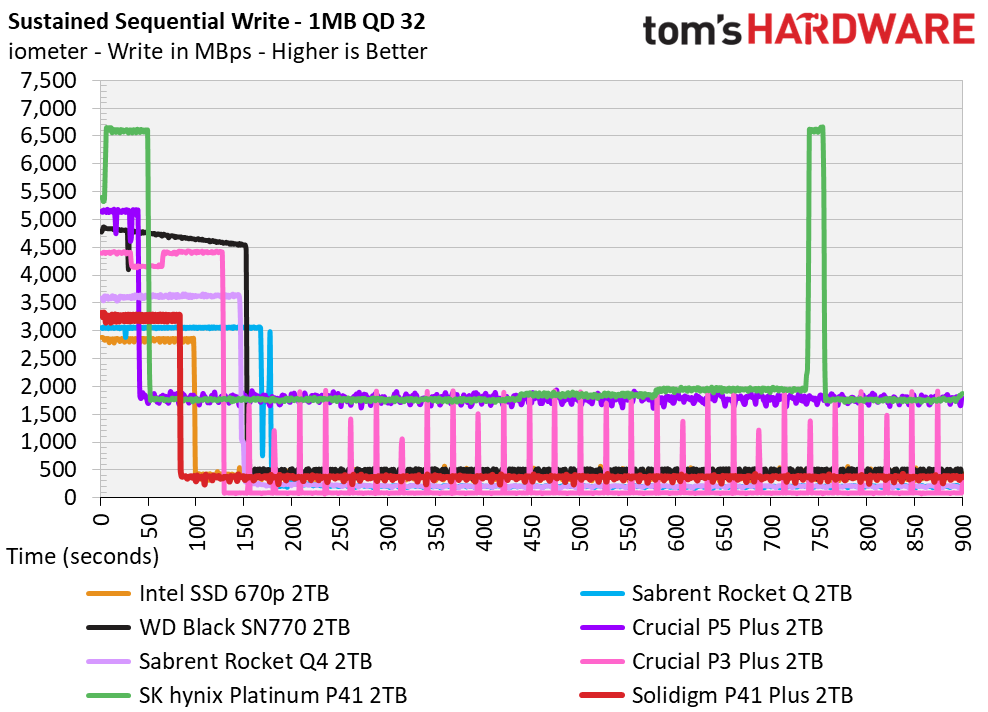
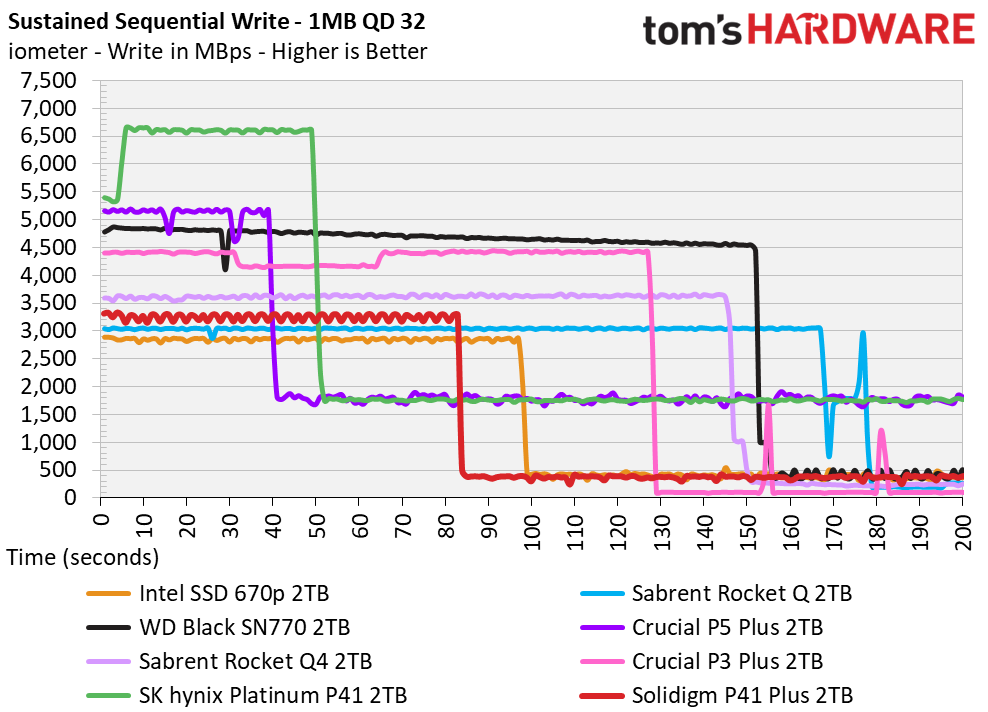
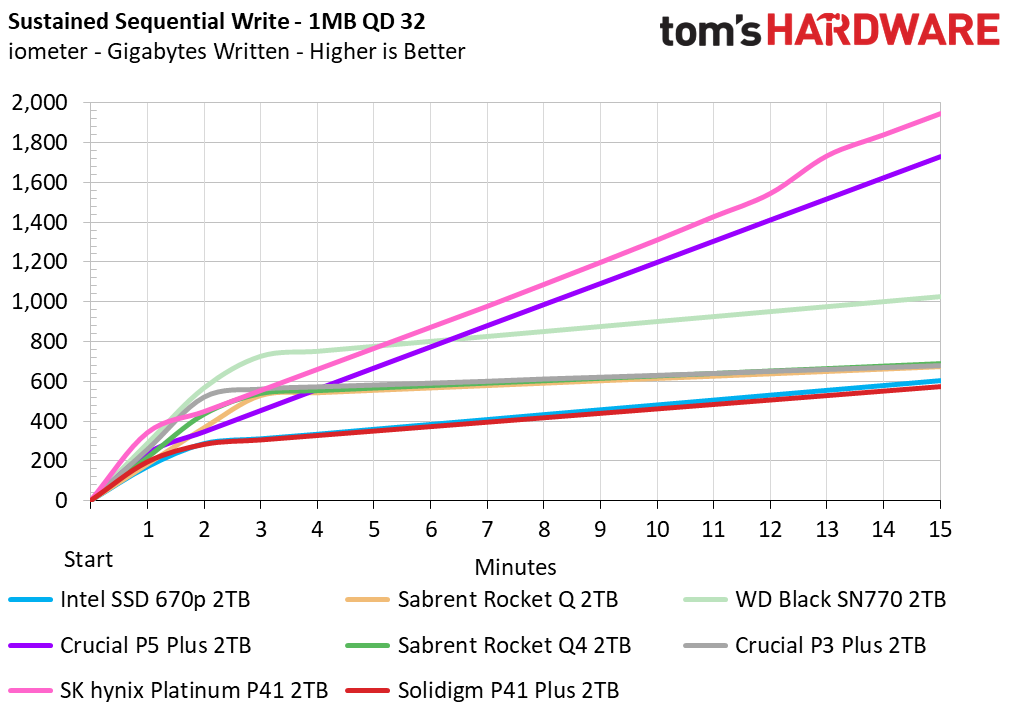
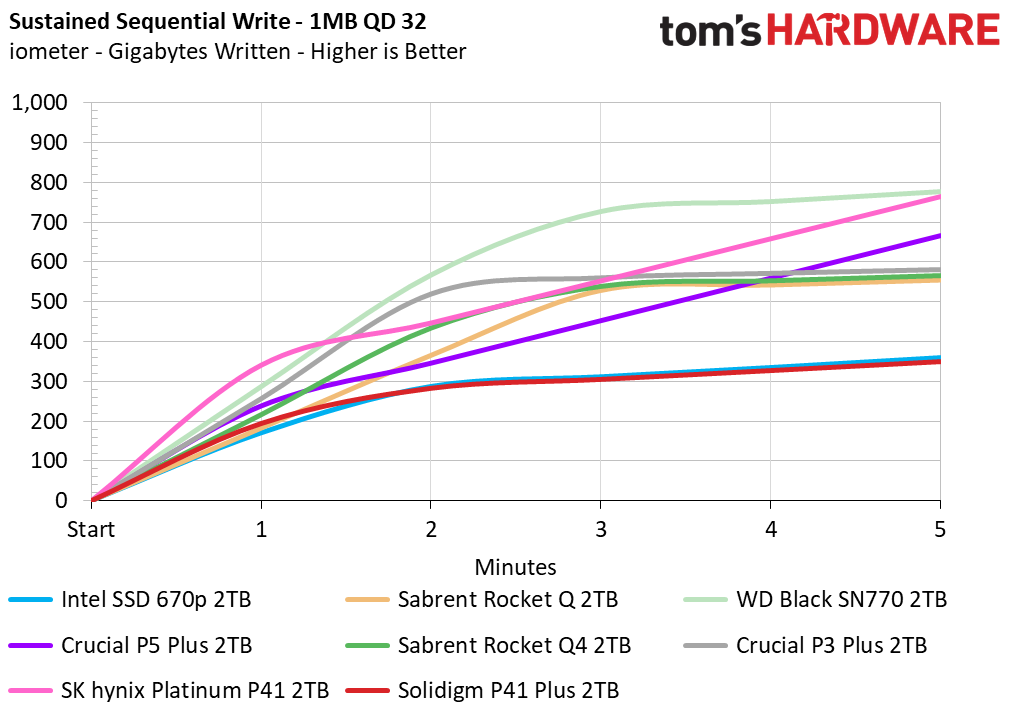
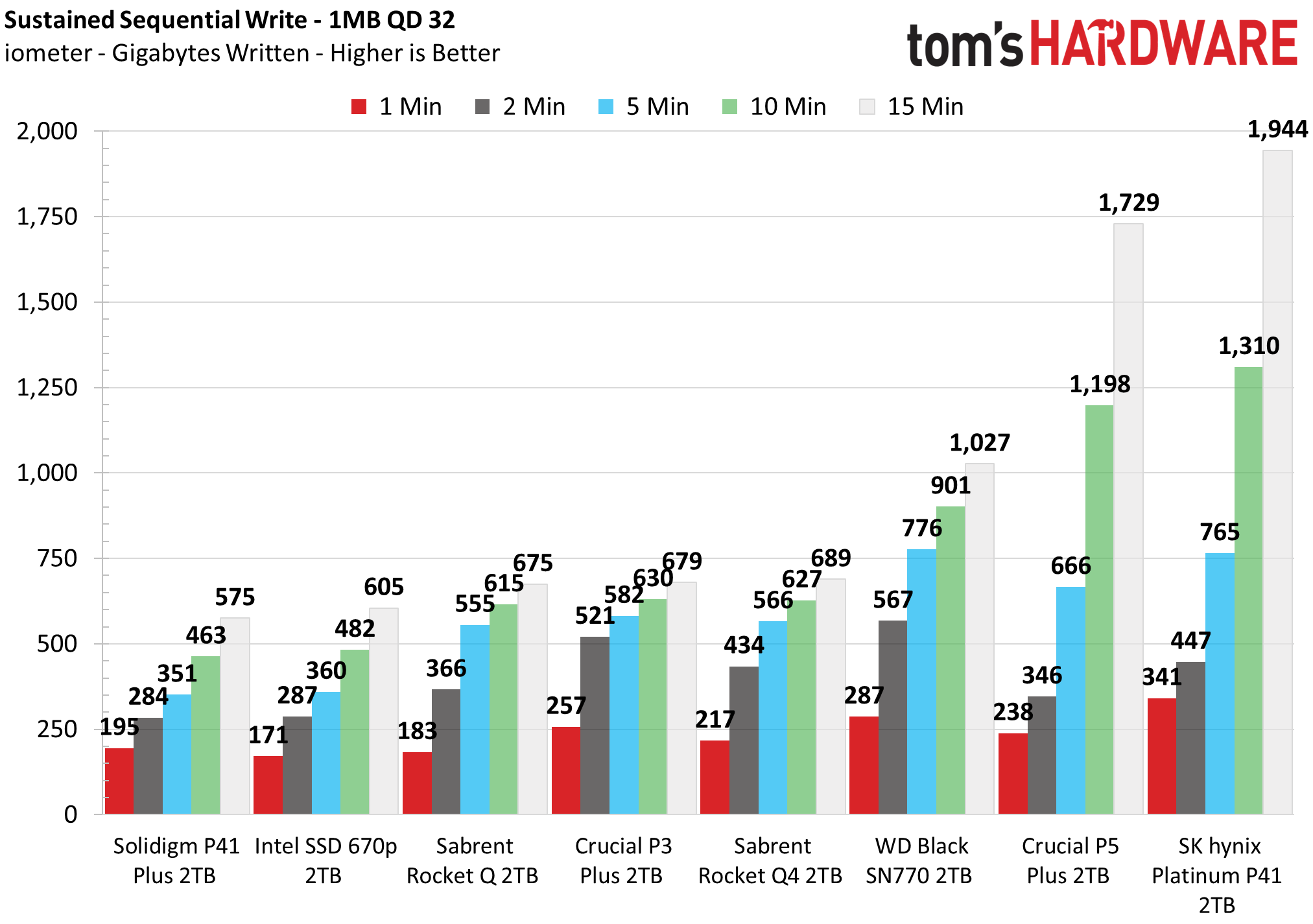
The P41 Plus uses a hybrid cache like the 670p, although this can be difficult to discern. Keen observers will see the pSLC cache pattern is slightly different for the first few seconds. The 2TB P41 Plus writes at around 3.25GBps for 83 seconds, equalling a cache of about 270GB. Officially, it’s declared to be 300GB with a substantial static portion. Static and dynamic pSLC cache have different characteristics, but the importance here is that the drive will always have some dedicated pSLC cache even when the drive is very full.
Once the pSLC cache is full, the P41 Plus begins writing directly to the QLC, which is much slower at around 400MBps. It matches the 670p but outperforms the P3 Plus. The SN770, with its massive cache but TLC flash, ends up about the same outside of pSLC. QLC drives are known for poor sustained performance, although this 144-layer flash is known to be the best on the market. Nevertheless, the P41 Plus’s cache should be sufficient under normal workloads.
Although a pSLC cache typically operates as a write cache, it is not uncommon for drives to use some of the pSLC for read caching. This is one reason drives may be reluctant to empty and recover the cache, another being that unnecessary pSLC cycling can increase wear. Solidigm takes this further with the P41 Plus — if a specific driver is installed. Then, if the drive is less than half full, the pSLC can act as a read cache for the “hottest” data, tracking it with its own driver versus Microsoft’s native NVMe option. It should be noted that, at this time, DirectStorage relies on Microsoft’s native driver.
PSLC writes faster than native QLC, but it also reads up to several times faster in terms of typical latency, so this can be a nice feature. This is especially true as general use is read-heavy, and certain data will be read more often, such as boot or OS data. Solidigm’s software can prioritize such data to make the cache more effective. However, there are certainly downsides to needing a driver for this feature if using a non-Windows OS. Additionally, there will be some overhead in tracking this information, such as potentially higher DRAM demands, but in practice, it should be negligible on a modern system.
Power Consumption and Temperature
We use the Quarch HD Programmable Power Module to gain a deeper understanding of power characteristics. Idle power consumption is an important aspect to consider, especially if you're looking for a laptop upgrade as even the best ultrabooks can have mediocre storage.
Some SSDs can consume watts of power at idle while better-suited ones sip just milliwatts. Average workload power consumption and max consumption are two other aspects of power consumption, but performance-per-watt is more important. A drive might consume more power during any given workload, but accomplishing a task faster allows the drive to drop into an idle state more quickly, ultimately saving energy.
We also monitor the drive’s temperature via the S.M.A.R.T. data and an IR thermometer to see when (or if) thermal throttling kicks in and how it impacts performance. Remember that results will vary based on the workload and ambient air temperature.
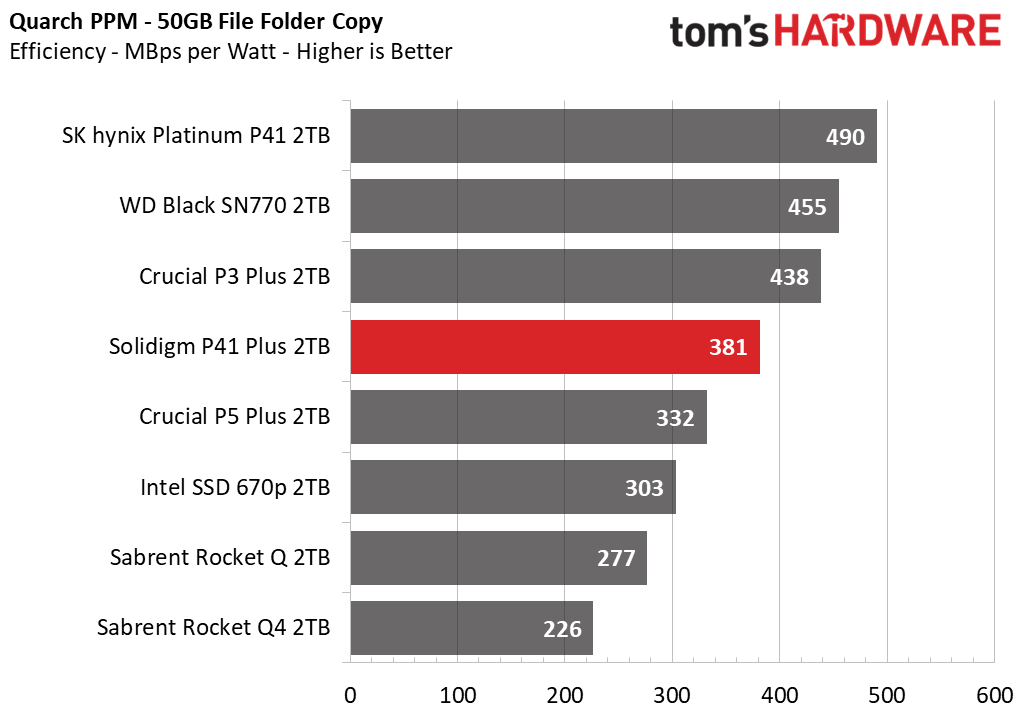
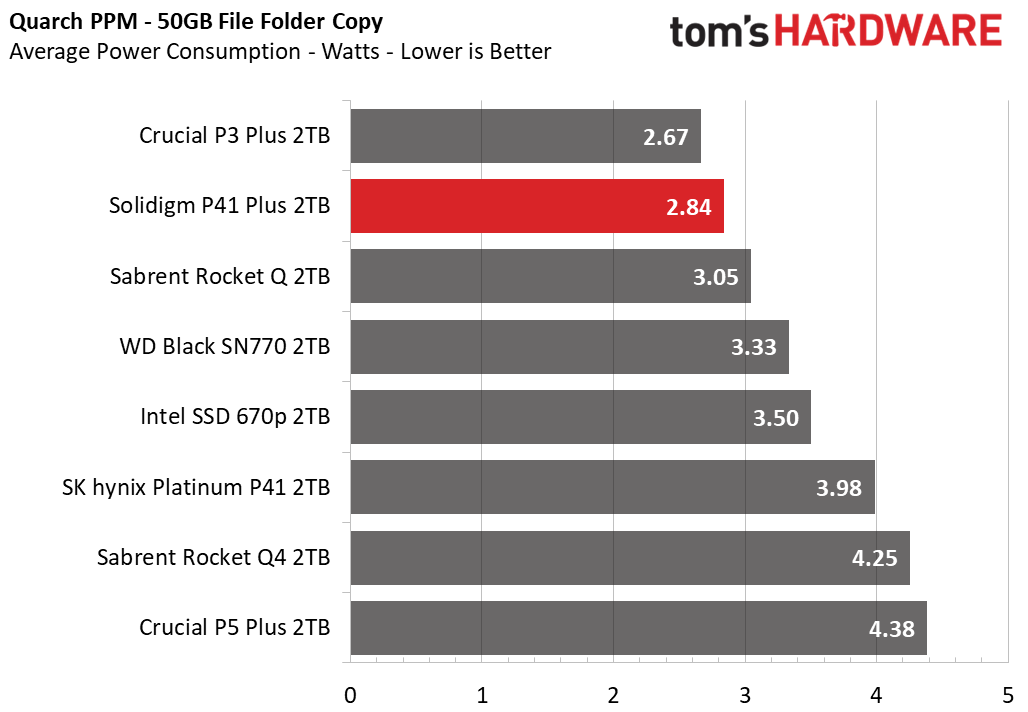
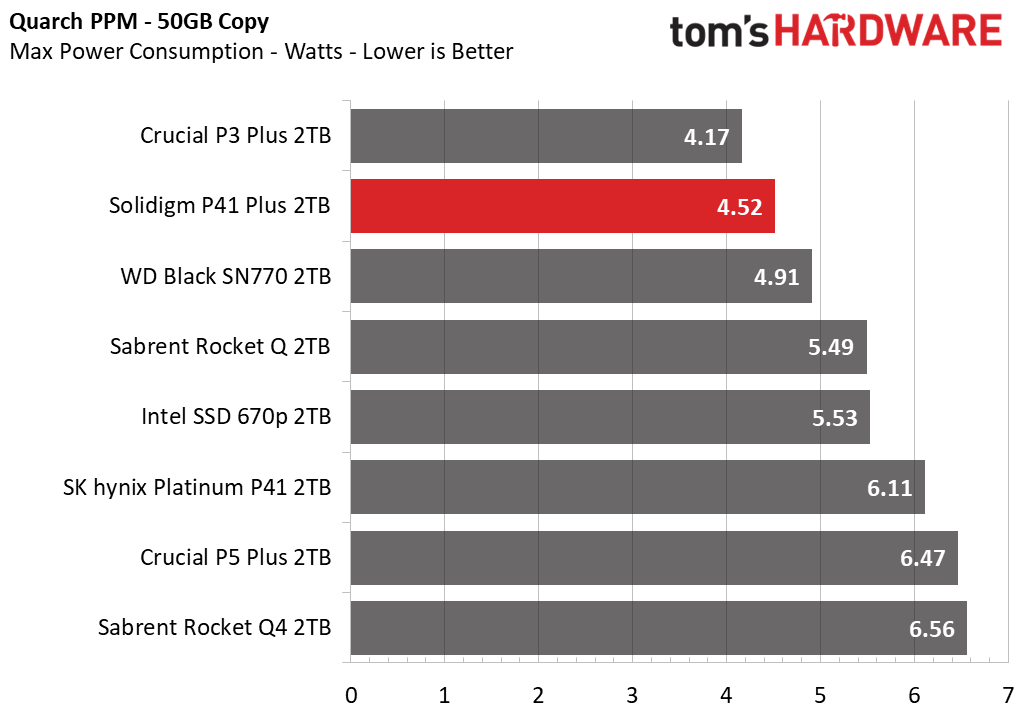
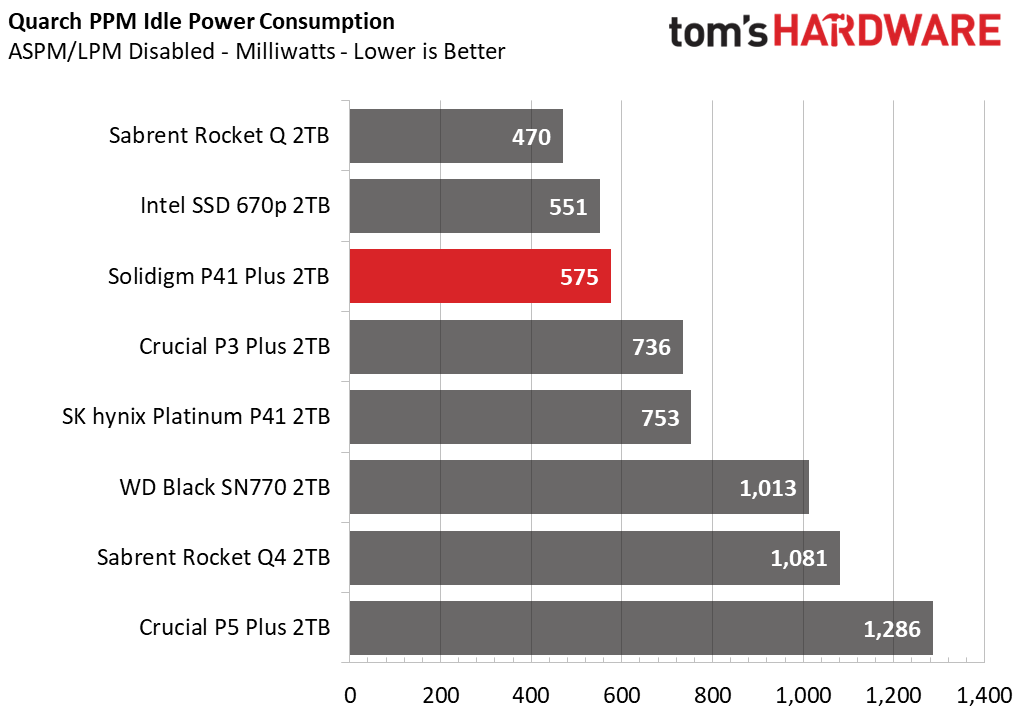
The 2TB P41 Plus has good idle power consumption, and although this matters most in battery-limited laptops, any proper NVMe drive should pull very little power when idle. Still, every bit helps on a desktop. In terms of efficiency, however, the P41 Plus is merely average. It does beat the older QLC drives but falls short of the P3 Plus, SN770, and Platinum P41. On the other hand, the Crucial P3, not shown here, proved to be super-efficient as a PCIe 3.0 version of the P3 Plus.
This is still a good showing, and we would absolutely recommend the P41 Plus for laptop use. However, there are reasons why it would be less efficient than the P3 Plus. We’ve already mentioned controller differences earlier in the review. There are also flash differences, including the I/O rate and architecture. For example, charge trap flash may be more power-efficient with simpler programming, although many potential factors exist. It’s possible Micron’s 176-layer QLC is a bit more efficient.
In either case, we did not expect the P41 Plus to have significant thermal issues. We measured it at 34C when idle. After writing 500GB of data, the drive peaked in the mid-60Cs. The drive is not fast enough post-pSLC to cause a throttling effect due to heat buildup.
Test Bench and Testing Notes
| CPU | Intel Core i9-12900K |
| Motherboard | ASUS ROG Maximus Z690 Formula |
| Memory | 2x16GB Corsair Dominator DDR5 5600 CL36 |
| Graphics | Intel Iris Xe UHD Graphics 770 |
| CPU Cooling | Arctic Liquid Freezer II - 420 |
| Case | Streacom BC1 Open Benchtable |
| Power Supply | Corsair SF750 Platinum |
| OS Storage | Sabrent Rocket 4 Plus 2TB |
| Operating System | Windows 11 Pro |
We use an Alder Lake platform with most background applications such as indexing, windows updates, and anti-virus disabled in the OS to reduce run-to-run variability. Each SSD is prefilled to 50% capacity and tested as a secondary device. Unless noted, we use active cooling for all SSDs.
Conclusion
The Solidigm P41 Plus looks to replicate Intel’s QLC SSD success and improve upon it. Much of the philosophy is the same, but Solidigm has also taken a streamlined approach: Make a simple, accessible drive aimed at real-world performance, and make it affordable, thus taking the lessons learned from the 660p line to make a better budget SSD. Solidigm backs it with good software and support but isn’t afraid to innovate. While requiring a unique Windows-based driver for full functionality is not ideal, it is at least an interesting concept to pursue.
Some might say that Intel’s QLC line was not a particularly smashing success. In fact, QLC has been slow to gain market share. However, its rise is inevitable, and investment in the technology now will pay off down the road. The 670p, in particular, was a solid drive, but newer technology and techniques can make it even better. Crucial’s P3 and P3 Plus have shown that you can get 4TB affordably with QLC on drives that perform well enough. The P41 Plus is perhaps a bit different, serving better as a primary budget drive, and more options are usually a good thing.
Still, there are probably too many good options in the SSD market right now, especially for PCIe 4.0. It is a good problem to have, but it may mean you have to be more selective when choosing a drive. The P41 Plus is a good option for prebuilts and, if priced right on sale, will be compelling as a single-drive option, particularly for laptops. The real-world performance, especially with light usage, is solid, even without the read cache feature. This is a good start for Solidigm, even if it’s not earth-shattering or super exciting.
MORE: Best SSDs
MORE: Best External SSDs and Hard Drives
MORE: How We Test HDDs And SSDs
MORE: All SSD Content

Shane Downing is a Freelance Reviewer for Tom’s Hardware US, covering consumer storage hardware.
-
Co BIY Any reason it is called the P41 other than to create confusion with it's high performance stablemate from SK Hynix ?Reply
It doesn't use the same controller, flash or even brand name.
I knew they were different and it was still confusing.
Well done review. It was very clear about the background and provenance of the company and the tech. -
twotwotwo Like the other commenter: imagine the meeting that led to the naming. 680p probably would make sense to consumers, because people know the 670p's positioning and it's a satisfactory followup to that. And if they're going to combine branding, they should just do that and call it Hynix P41. I'm not sure if "P41 Plus" communicates that it's the value option well enough, but also, I pay too much attention to SSDs to have a good intuition for how normal people will see it. (Maybe use previous gen's brand, P31 Max/SE/???)Reply
But seems great that this exists--8 cents a gig at 2TB with performance that's plenty for many people's use cases. -
PiranhaTech This is making me wonder if a QLC drive with a cache makes sense for a video game drive for a secondary (I still would prefer TLC for the OS drive right now). The cache might be large enough to hold the majority of a a few video games. Apparently the cache can be as large as 280GB in one report.Reply
I saw one benchmark for a mid-tier SSD, and what got me to get it was "here's the loading time. If you pay $50 more, you save... 2 seconds off your loading time" since it was a secondary SSD. -
USAFRet Reply
99% of people can't tell the difference between PCIe 3.0 and 4.0.PiranhaTech said:This is making me wonder if a QLC drive with a cache makes sense for a video game drive for a secondary (I still would prefer TLC for the OS drive right now). The cache might be large enough to hold the majority of a a few video games. Apparently the cache can be as large as 280GB in one report.
I saw one benchmark for a mid-tier SSD, and what got me to get it was "here's the loading time. If you pay $50 more, you save... 2 seconds off your loading time" since it was a secondary SSD.
Even though the sequential numbers for 4.0 are twice that of the 3.0.
We are deep into diminishing returns here.
4YoRKQy-UO4View: https://www.youtube.com/watch?v=4YoRKQy-UO4
4DKLA7w9eeAView: https://www.youtube.com/watch?v=4DKLA7w9eeA
GQ9LyNXpsOoView: https://www.youtube.com/watch?v=GQ9LyNXpsOo -
jackt interesting efficiency ! I wish samsung 880 and skhyncs p31 were in the tests.Reply
Anyway i think people are waiting for samsung 890 and pcie5 ssds... -
PiranhaTech Reply
The other factor is if your PC has a lot of RAM, Windows might have parts of the game in RAM already. Windows I think will preload things based on the time of day.USAFRet said:99% of people can't tell the difference between PCIe 3.0 and 4.0.
Even though the sequential numbers for 4.0 are twice that of the 3.0.
We are deep into diminishing returns here.
4YoRKQy-UO4View: https://www.youtube.com/watch?v=4YoRKQy-UO4
4DKLA7w9eeAView: https://www.youtube.com/watch?v=4DKLA7w9eeA
GQ9LyNXpsOoView: https://www.youtube.com/watch?v=GQ9LyNXpsOo -
Co BIY When operating a PCIe 4.0 DRAM-less SSD on a 3.0 PCIe connection do they underperform more than expected because of the transfers required to system RAM?Reply
Does this change the recommendations for installing on a PCIe 3.0 limited system?
I just purchased a Solidigm P41 Plus SSD 2TB from NewEgg for $109. I wish it came in a 4TB.
I think the price promise of QLC is finally here. -
USAFRet Reply
The slowest device in the chain dictates performance.Co BIY said:When operating a PCIe 4.0 DRAM-less SSD on a 3.0 PCIe connection do they underperform more than expected because of the transfers required to system RAM?
Does this change the recommendations for installing on a PCIe 3.0 limited system?
I just purchased a Solidigm P41 Plus SSD 2TB from NewEgg for $109. I wish it came in a 4TB.
I think the price promise of QLC is finally here.
A PCIe 4.0 drive, in a PCIe 3.0 port, can only run at PCIe 3.0 speed.
DRAM or not.
The very fastest PCIe 4.0 or 5.0 drive in a PCIe 3.0 port....you get 3.0 speed.
Period. -
PiranhaTech Reply
Will be running at PCIe 3.0, but you should consider one thing: 4k read. The PCIe 4.0 SSD might have faster 4k read, and often 4k read on a PCIe 4.0 drive won't be able to saturate PCIe 3.0. The faster drive can still have an impact.Co BIY said:When operating a PCIe 4.0 DRAM-less SSD on a 3.0 PCIe connection do they underperform more than expected because of the transfers required to system RAM?
Does this change the recommendations for installing on a PCIe 3.0 limited system?
I just purchased a Solidigm P41 Plus SSD 2TB from NewEgg for $109. I wish it came in a 4TB.
I think the price promise of QLC is finally here.
One of the best tools, ESPECIALLY for a secondary SSD, is to look at real-world benchmarks. Many video games don't have a difference off a slower SSD. I'm talking 0.1-2 seconds from a 12 second load -
USAFRet Reply
And in a blind test with any normal consumer use case, I defy anyone to tell the difference in any of these configurations.PiranhaTech said:Will be running at PCIe 3.0, but you should consider one thing: 4k read. The PCIe 4.0 SSD might have faster 4k read, and often 4k read on a PCIe 4.0 drive won't be able to saturate PCIe 3.0. The faster drive can still have an impact.
One of the best tools, ESPECIALLY for a secondary SSD, is to look at real-world benchmarks. Many video games don't have a difference off a slower SSD. I'm talking 0.1-2 seconds from a 12 second load
